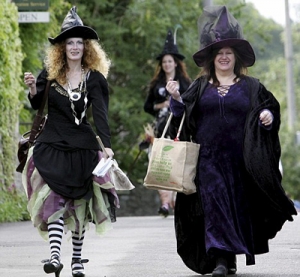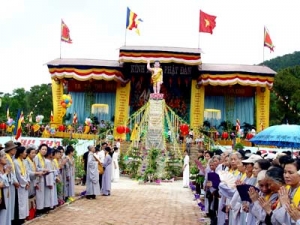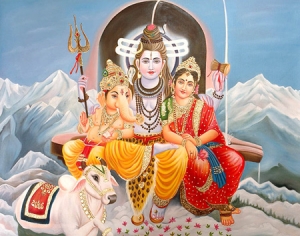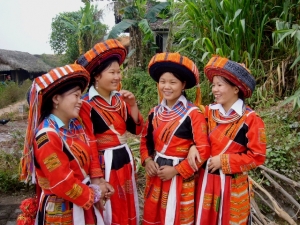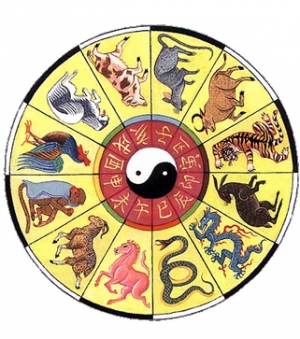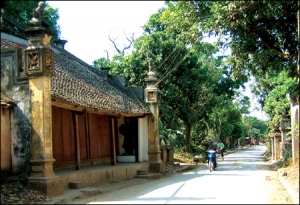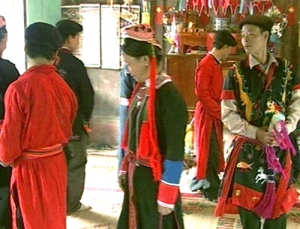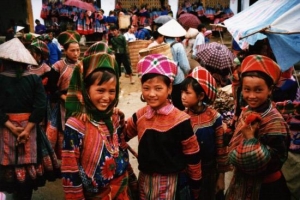
Asia Pacific Travel Team
Shamanism in Vietnam
Despite the existence of shamanism in mainstream religion in Vietnam, it is mostly found in the traditions of the country’s ethnic minorities,many of whom retain a shaman in each village.
The shaman
A shaman is an intermediary between humankind and the spirit world,occupying a role similar to that of a priest:a religious specialist,possessing the ability to communicate with spirits,to appeal to them to dispel evil,to explain turns of fate,and to transmit the instructions of spirits. He or she usually has healing and magical powers,and can influence the spirits to bring about good and evil.
The practice of shamanism
There are several elements of shamanism in Taoism. Killing and expelling demons with the aid of charms and incantations,invoking spirits,holding ritual offerings,and presenting written memorials to spirits with the aid of a medium are all shamanistic practices.
Shamanism is not unique to Asia. Most of the long-established religions have elements of its beliefs and practices – the rite of exorcism in Christianity,for example,in which a priest attempts to communicate with,and expel,an evil spirit from another person,an animal or an inanimate object such as a house.
Shamanism in Vietnam
Although shamanism exists in mainstream religion in Vietnam,it is mostly found in the traditions of the country’s ethnic minority groups,many of whom retain a shaman in each village. To invoke the spirits,a shaman uses songs and dances,spells and talismans leading to the induction of a trance-like state during which he or she is in direct contact with spirits.
In theory,such activities are labeled as superstition and are illegal. However,the law is largely ignored,and even the authorities recognize the tourism potential of such rituals. As an example,one ethnic group in the Central Highlands has a traditional annual festival in which the highlight is the ritual slaughter of a buffalo as a sacrifice to the spirits. This gory spectacle is now being promoted by the tourism department of the area and has become very popular.
The fortune-teller
Another type of shaman specializes in divination,a common practice throughout the country. Vietnamese people believe that there are good days and bad days,and one’s future welfare depends upon choosing the most propitious date and time before undertaking any significant venture or activity.
Divination by astrology is the main tool to be used to determine what day a person should move house,apply for a job or get married:in each case,the verdict of the fortune teller is taken very seriously. The recommendation is almost invariably followed to the letter. The cost of this service is seldom cheap,sometimes running into hundreds of dollars – a large sum in a poor country.
Sometimes the outcome is highly inconvenient – having to move house in the middle of the night,for example. In other cases,the advice can lead to major life changes – an ‘unsuitable match’ verdict upon a couple (or one of the sets of parents) seeking guidance upon a possible marriage almost inevitably leads to a break-up.
A man will sometimes consult the shaman to ask how he should deal with what he considers his wife’s unsuitable behavior (deep-rooted Confucian subservience inhibits women from doing the same). Sometimes,this leads to divorce. Young people sometimes spend several months’ salary seeking a way forward after rejection by a girl or boyfriend.
Hoa Hao Sect
Hoa Hao, which is more bent towards traditional Buddhism, is concentrated in the Mekong Delta with a membership estimated at about two million.
This religious sect based on Buddhism founded in 1939 and to date there are around two million followers throughout Vietnam. In some provinces near its home-land, 90% of the population practices this tradition.
An important characteristic of this sect is its emphasis on peasant farmers, exemplified by the old slogan "Practicing Buddhism While Farming Your Land." Farm life is considered to be the most conducive to religious practice and self-improvement. Patriotism and willingness to defend the homeland are valued.
Hoa Hao also stresses the practice of Buddhism by lay people in the home, rather than focusing primarily on temple worship and ordination. Aid to the poor is favoured over pagoda building or expensive rituals; religious and social ceremonies are ideally simple and modest, and are not to include the food offerings, divination services, and elaborate wedding and funeral customs found in some manifestations of Southeast Asian life. These are viewed as a waste of money which would be better spent helping the needy.
Shiva in Saigon
South Vietnam, everyone knows, is a land of Buddhists, Christians, Confucianists and animists. Shiva reigns in Hindustan. But a wide variety of sects and religions flourish in this country, and Shiva himself is worshipped everyday in Saigon temples. His devotees are both Indians and Vietnamese.
Mariammane Temple
The next time you're in Saigon and want a genuine touch of India without going there, take a taxi or pedicab down to the Central Market and stop at 45 Truong Cong Dinh Street. We did, and found that the crowd of worshippers outside were mostly women. There's a reason for that. Of the three Southern Indian temples in Saigon, this one, Mariammane Temple, is for women
.
Sculptured Indian deities, perched high on the facade of the temple, were looking over the Saigon street scene of cyclo drivers, coconut carts, a woman astrologist and kiosks selling beer and soft drinks. Inside the temple was C. Vellaichamy of Madras State, an ash mark between his eyebrows. He stood in a white cotton wasthi, surrounded by his gods and the sensuous, aromatic flavors of burning incense and sacramental malikai flowers.

"Every day about 2,000 people come for prayer, every day," he said. 'Seventy percent are women. " The women we saw were mostly Vietnamese, and they looked devout. They had come for prarthani (prayer) and to worship the virtues of Shiva in his manifold reincarnations. One of these reincarnations included the supreme lingam of the god, potent phallic symbol of fertility and everlasting reproduction. In a scene not unrelated to one of the scenes in D.H. Lawrence's novel, Lady Chatterly's Lover, the women were placing sweet-scented flowers on the immortal organ of Shiva. The ritual seemed very charming, naive and deeply human. It did not smack of the hard, automaton pornography that flourishes in certain urban areas of the modern world today. Vellaichamy stood under a picture of Mahatma Ghandi that was framed and draped with a garland of flowers. "Many beggars also come to Mariammane Temple," he said. Vellaichamy arrived here in 1970 from Southern India. "I am temple accountant. I also buy bananas and coconuts for the gods."
Mariammane temple, named after a very large temple in India, was built by Indian craftsmen about 80 years ago. Of the two other Southern Indian temples in Saigon, the one on Cong Ly Street was built about 100 years ago and the one on Ton That Thiep Street is 60 years old. These two temples are for men. Only Mariammane is ladies' temple.
Advocates of Women's Lib. might find some objectionable images in the temple. Vellaichamy was standing beneath one of them, or rather two of them: The male god, Paramasivam located next to his wife. Parvathi. Parvathi was holding one of their two sons, Murgan. But Paramasivam was decked out far more splendidly than his wife. In addition to a golden trident and a variety of lively green cobras he was equipped with four arms. His wife Parvathi, however, was equipped with fairly plain dress and only two arms.
But the faithIul still come to the temple. Of the more than 1000 Indians in Saigon, many are Muslims who attend the local mosque. Vellaichamy estimates thar 450 are Hindus. This indicates that most of the ladies who come to the gods at Mariammane Temple are Vietnamese or Chinese. They are drawn to the jasmine-scented aura of Shiva, Vishnu and the female entourage that includes the golden-skinned Valambigal, Kanniga, Kammatchi, Amman, the two-armed Andal and Birman, the lady goddess of three faces.
"All Hindus come here. Buddhist people come too, come for the prayer. They like the Mariamane. Indian Muslim donot come because only have one god, named Allah. But Buddhist people, like Hindu, have many gods."

![]()
The artistic riot of graven images around the temple bears witness to this polytheistic profusion. The gods are everywhere. The temple, drenched with incense, seems almost drunk with them.
"In Southern India we have many lady gods, many man gods. We have 1,000 temples, 200 gods. Shiva the number one god, main god."

And who was Vishnu and the blue-skinned Krishna?
"Krishna best friend of Shiva. Vishnu same as Krishna, in different form."
The guru of the temple is Vaithinata Iyar, 65 years old. "He comes every morning at 9 o'clock. every evening at 6 o'clock, to lead the prayer."
Source: Vietnam Magazine
Sapa's weather, best time for travelling
The climate of Sapa is highly seasonal, with a subtropical climate in the summer and a temperate climate during the winter. Average temperature for Sapa town is 15.4ºC, with a maximum of 29.4ºC and a minimum of 1ºC. Sapa , is a frontier town and capital of Sa Pa District in the Lao Cai province in northwest Vietnam. It is one of the main market towns in the area, where several ethnic minority groups such as Hmong, Dao (Yao), Giay, Pho Lu, and Tay live.
The Lunar Calendar in Vietnam
As with the Chinese, the Vietnamese lunar calendar begins with the year 2637 B.C. It has 12 months of 29 or 30 days each, and the year totals 355 days.
At approximately every third year, an extra month is included between the third and fourth months. This is to reconcile the lunar calendar with the solar one.
The Vietnamese like the lunar calendar because they can be sure of a full moon on the 15th day of each month. in their everyday life, however, they use the Gregorian calendar.
Unlike our centuries of 100 years, the Vietnamese calendar is divided into 60-year periods called "Hoi".
This "Hoi" or 60-year period is divided into two shorter cycles; one of a ten-year cycle and the other of a 12-year cycle.
The ten-cycle, called "Can" is composed of ten heavenly stems. Their names and approximate translation follow.
1.Giap water in nature
2. At water in the home
3. Binh lighted fire
4. Dinh latent fire
5. Mau wood of all types
6. Ky wood set to burn
7. Canh metal of all kinds
8.Tan wrought metal
9. Nhamvirgin land
10.Quy cultivated land
The 12-year cycle, "Ky", has 12 earthy stems represented by the names os 12 names in the zodiac. Their names and translations in order are:
1. Ty the rat
2. Suu the buffalo
3. Dan the tiger
4. Mao the cat
5. Thinthe dragon
6. Ty the snake
7. Ngo the horse
8. Mui the goat
9. Thanthe monkey
10.Dauthe cock (the chicken)
11.Tuat the dog
12.Hoi the pig
A Vietnamese year is named after the combination of one of the names of the ten heavenly stems and one of the names of the 12 earthly stems. For instance, 1964 was the Year of the Dragon, "Giap-Thin". Giap is the first of the ten-year cycles and Thin is the fifth of the 12-year cycle. The year 1965 was "At-Ty". This follows down the line each year. The ten-year stem is not usually mentioned when discussing the year. Thus, we hear, "The Year of the Dragon" or the "Year of the Snake", etc., etc., Giap-Thin, the Year of the Dragon, will not return for a 60-year period. This is true of all combinations.
Beliefs and religions in Hung Yen
Most of habitants in Hung Yen province are farmers. Wet rice cultivation is their main livelihood, which is attached to the conquering process of the Red River Delta. Therefore, Hung Yen`s civilization and culture are the wet rice civilization and culture, and the Red River civilization and culture, too.
Villages in Hung Yen are located along river basins or gather into small hamlets scattering on rice fields or around areas, which are surrounded by green bamboo ramparts. Each village has a communal house beside a century-old banyan tree and big water well. The banyan tree, water well and communal house`s yard have not only rooted deeply in the mind of local people from their childhood, but also left a fadeless print in expatriates` mind.
Looming behind green bamboo ramparts are communal houses, pagodas, temples and shrines. From a long distance, waving roofs of the communal house can be seen among luxuriant green tree canopies. Huge ancient trees surround the house and their green leaves embellish the roofs, making the scenery more vivid. Trees at pagodas and temples are secular ones green all the year round, such as banyans, fig trees, longan and bombax.
A pagoda in Hung Yen is often built in the "noi cong ngoai quoc" architectural style which means Cong (Chinese character: Gong) in the inner part and the Quoc (Chinese character: Guo) in the outer. In the pagoda`s inner part, there are two rows of houses laying in parallel and linked by a transversal house called Thieu huong (Incense Burning) where Buddhist rites are conducted. In its outer part, there are two roof corridors linking the front with the rear of the two main buildings forming a rectangular frame. Each pagoda has a three-door Entrance (Tam Quan) featuring three different mysterious views of the Buddha about the world. Passing by the three-door Entrance is the Tam Bao area, which includes three houses: Tien duong (Ancestor-worshipping House), Thieu huong (Incense Burning House) and Thuong dien (Sanctuary). At present, in Hung Yen, there remain some relics of Huong Lang (Lang) Pagoda (in Minh Hai commune) built in the Ly dynasty and Thai Lac Pagoda (in Lac Hong commune, Van Lam district) built in the Tran dynasty. These are Hung Yen`s most ancient pagodas having great architectural and sculpturing values.
Legend has it that Huong Lang Pagoda was built by Queen Mother Y Lan. However, the pagoda was destroyed in the resistance war against the French colonialists. Its relics include a stone lion, four big stone pillars and ten stone weasels standing on doorsteps. Besides, there remain many art patterns of flying phoenix and chrysanthemum dating back to the Ly dynasty. In addition, Thai Lac Pagoda has preserved 16 wood carving boards, which date from the Tran dynasty. The boards have different features such as a fairy offering incense while riding a phoenix, a fairy playing music or playing the flute, a fairy sleeping in the clouds, fairy offering flowers. All the boards` carving lines are very skillful, reflecting the Vietnamese social life in the Tran dynasty.
Unique architectural features of pagodas and temples in Hung Yen are also displayed in the architecture of Da Nguu Temple (in Van Giang district) with 100 carved pillars, of Da Hoa Temple (Binh Minh commune, Khoai Chau district) with 18 board-shaped ridges, of Ung Temple (An Thi district), An Xa Temple (An Vien commune, Tien Lu district) with a Cham-style terra-cotta tower and a stone-sculpture sanctuary
The Pho Hien relic complex consists of 12 nationally recognized relics built in Chinese-style architecture. Along with their typical architectural features, these relics have preserved many offering items, palanquins, hammocks, horizontal lacquered boards, many pairs of wood panels with skillfully inscribed parallel sentences.
Hung Yen ranks fourth nationwide in terms of the number of relics. It boasts over 800 historical and cultural relics, 132 of which are recognized as national sites, and many of them are belief and religious works.
The cult of agricultural divinity worship in Ha Nam
Locating in the southern west part of the Red river delta, Ha Nam is a half-mountain half-plain area and heavily agricultural dependent. The farmers here are now still preserving the ancient custom of worshiping the agricultural divinities; the most outstanding one is the worship for the four Dharma.
The cult of worshiping the village`s tutelary genie
The cult of worshiping the tutelary genie was imported from China and had become part of Vietnamese people`s spiritual life and had been diversified.
 The village`s tutelary genie can be a genie coming from heaven like Phu Dong Thien Vuong, a genie of mountain like Tan Vien, a peson who had a great contribution to the country like Ly Thuong Kiet, Tran Hung Dao, Yet Kieu, Da Tuong, and also some evils. There are a lot of mysterious or even illogical legends around these genies. Those titled by the King always represent the history, ethics, traditions and regulations of village. The tutelary has an invisible power that somehow manages the whole village in an orderly way.
The village`s tutelary genie can be a genie coming from heaven like Phu Dong Thien Vuong, a genie of mountain like Tan Vien, a peson who had a great contribution to the country like Ly Thuong Kiet, Tran Hung Dao, Yet Kieu, Da Tuong, and also some evils. There are a lot of mysterious or even illogical legends around these genies. Those titled by the King always represent the history, ethics, traditions and regulations of village. The tutelary has an invisible power that somehow manages the whole village in an orderly way.
The King often titled tutelary genie in three levels: the superior, the middle and the inferior according to their contribution to the village. They were also promoted to higher level if they could better the life of the people. The King promoted them according to the suggestions of the villagers. The petition must be sent to the King in a certain time of the year. When it is approved, the royal honor would be sent to the village, and people put it in the Common house.
The tutelary genie is also called the Blessing genie that blesses the life of the people in the village. One village might worship more than one genie. They can be male or female, depend on the legends of each village.
In Vietnam, each village has their own common house to worship the tutelary genie. It is considered the symbol of the people`s spiritual life. This is not only the place for worshiping but also the place for village dignitaries to meet and for the people to enjoy the village`s activities.
For each Vietnamese people, the tutelary genie is the supreme power that regulates the life of the villagers, who protects and blesses them with prosperity and health. The people of the village, generations by generations, are living under the protection of the immortal tutelary genie, who represent the history of the village.
The tutelary genie is the supreme commander of the village in both spiritual and material life. So, the practice of worshiping the tutelary is by no means the worship for the village`s regulations and manners of the community. It is also the invisible force that links all the villagers in solidarity and understanding; preserves the values of the village. That`s why all member of the community, both the dignitaries and the people, have to prepare and offerings to ask for permission before organizing a festival. Perhaps this gratitude is similar to that for the worship of their ancestors.
Nowadays, festivals are blossoming everywhere. Such activities like performing the legend of the genie, organizing processions and offerings are being recovered as a sing of gracefulness of the people to their tutelary genie, who had great contribution to the community.
Customs and habits of Dao ethnic group
Name of ethnic group: Dao ("Dao Quan Trang" (Dao with white trousers), "Dao Quan Chet" (Dao with tight trousers), "Dao Tien" (Dao with coins), "Dao Thanh Y" (Dao with blue dress), "Dao Do" (Red Dao), Man, Dong, Trai, Xa, Diu Mien, Lim Mien, Lu Giang, Lan Ten, Dai Ban, Tieu Ban, Col Ngang, Col Mua and Son Dau).
Customs and habits of Mong (H`Mong) ethnic group
Name of ethnic group: Mong (H`Mong): (Mong Do, White Mong, Mong Lenh (Variety Mong), Mong Si (Red Mong), Mong Du (Black Mong) and Mong Sua (Man Mong).
Population: 787,604 people (Year 1999).
The Mong are concentrated in Ha Giang, Tuyen Quang, Lao Cai, Yen Bai, Lai Chau, Son La, Cao Bang and Nghe An provinces.
Each lineage lives within a group setting. The head of the village assumes the common affairs for the lineage. Young Mong men and women are free to choose their partners. Marriages are absolutely forbidden between men and women of the same lineage. Matrimonial life of the Mong is very harmonious and divorce is very rare.
Mong language belongs to the Mong-Dao Group. The Traditional Tet (New Year`s Day) of the Mong is organized every December. They refrain from eating green vegetables during the three days of the Tet Holiday. The musical instruments of the Mong include various kinds of "khen" (pan-pipes) and lip organs. After a hard working day and to celebrate spring, the young men and women often play "khen" and lip organs to express their feelings for their partners.
The Mong live mainly on slash-and-burn cultivation. They also grow rice and corn on terraced fields. Their principal food plants are corn, rice, and rye. Apart from these crops, they also grow medicinal plants and linen plants to supply the fibers for cloth weaving.


